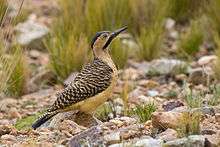Andean flicker
The Andean flicker (Colaptes rupicola) is a South American species of woodpecker. It is found in grassland, shrubland and Polylepis woodland at altitudes of 2,000–5,000 metres (6,600–16,400 ft) in the Puna ecoregion. Together with the campo flicker and ground woodpecker, it is one of the few largely terrestrial woodpeckers.
| Andean flicker | |
|---|---|
 | |
| Scientific classification | |
| Kingdom: | Animalia |
| Phylum: | Chordata |
| Class: | Aves |
| Order: | Piciformes |
| Family: | Picidae |
| Genus: | Colaptes |
| Species: | C. rupicola |
| Binomial name | |
| Colaptes rupicola D'Orbigny, 1840 | |
Description
A large woodpecker, it grows to a length of about 32 cm (13 in). It has a long tail, rounded wings (noticeable in flight) and a long powerful beak. The head and throat are largely white or buff, marked by a black crown and nape and a dark malar stripe, tinged reddish in the male in some subspecies. Body upper parts are boldly barred in black or dark brown and buff. The upper wings are brown and slightly barred and the under wings are yellowish. The tail coverts are white with slight brown barring, the upper tail is blackish with fine barring at the sides and the under tail has buff edges. Underparts are cream or buff with some darker speckling, the breast sometimes being tinged with orange. The beak is black, the iris yellowish and the legs grey, pink or buff.[2]
Distribution and habitat
The species is native to Peru, Chile, eastern Bolivia and northeastern Argentina. Its altitudinal range is between about 2,000 and 5,000 m (6,600 and 16,400 ft).[1] More common habitat types occupied are high mountain terrain with rocky outcrops, stones, scrub, grassland and alpine tundra, including páramo and puna grassland. It is sometimes found in the upper parts of the tree zone, plantations and woodland patches.[2]
Ecology

The Andean flicker is unusual among woodpeckers in that it is found in open country, largely devoid of trees, and forages on the ground, the Latin adjective rupicolus signifying "inhabiting among rocks". It often feeds in family groups, keeping in touch with other birds by constant chatter and uttering a number of different vocalisations, including a scolding alarm call given in flight. It seldom, if ever, drums. The diet is mainly insects, which it finds by sweeping away debris on bare ground with its beak and probing into the soil and grass clumps.[2] Nests occupy holes that it digs in soft soil in cliffs or on banks. Another unusual feature is that it often nests colonially rather than alone, as do most woodpeckers.[3]
Status
C. rupicola is a fairly common species with a very wide range. No particular threats have been identified and the population is assumed to be stable. The International Union for Conservation of Nature has assessed its conservation status as being of "least concern".[1]
References
- BirdLife International (2017). "Colaptes rupicola". IUCN Red List of Threatened Species. 2017: e.T22726426A112111487. doi:10.2305/IUCN.UK.2017-1.RLTS.T22726426A112111487.en.
- Gorman, Gerard (2014). Woodpeckers of the World: A Photographic Guide. Firefly Books. pp. 359–361. ISBN 177085309X.
- "Andean Flicker: Colaptes rupicola". Neotropical Birds Online. Ithaca: Cornell Lab of Ornithology. 2010. Retrieved 25 March 2017.
External links
- Andean Flicker videos on the Internet Bird Collection
- Andean Flicker photo gallery VIREO
- Photo-High Res; Article borderland-tours
- Aves de Chile: Andean Flicker – Description and photos
